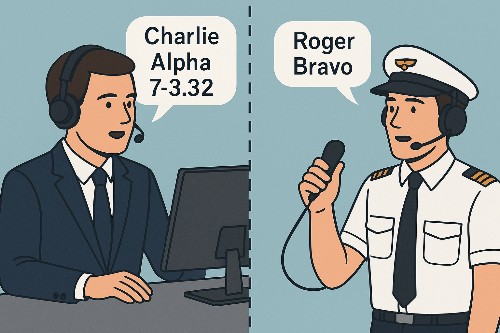What Is the ICAO
Phonetic Alphabet?
 ICAO phonetic alphabet
ICAO phonetic alphabetThe ICAO phonetic alphabet assigns specific code words to each letter of the English alphabet, ensuring clarity in verbal communication. This system is also known as the NATO phonetic alphabet and is used globally in aviation, military, and other fields requiring precise communication.
Why Is It Important?
In aviation, miscommunication can lead to serious incidents. For example, the letters "M" and "N" can sound similar over radio transmissions. Using "Mike" and "November" instead reduces the risk of confusion. This standardized system ensures that pilots, air traffic controllers, and ground staff understand each other clearly, regardless of their native language or accent.
When Is It Used?
Pilots use the ICAO phonetic alphabet in various situations, including:
- Communicating aircraft registration numbers (e.g., "N123AB" becomes "November One Two Three Alfa Bravo").
- Spelling out waypoints or locations.
- Clarifying information during poor radio reception.
- Confirming ATIS (Automatic Terminal Information Service) information, which uses sequential phonetic letters to identify updates (e.g., "Information Bravo").
Tips for Learning the Phonetic Alphabet
- Flashcards: Create flashcards with the letter on one side and the corresponding code word on the other.
- Practice Spelling: Spell out your name or common words using the phonetic alphabet.
- Listen to ATC Communications: Familiarize yourself with real-life usage by listening to air traffic control communications.
- Use Mnemonics: Associate each code word with an image or concept to aid memory.
-
Regular Review: Consistent practice will help reinforce your knowledge.
If you want to check out the ICAO phonetic alphabet chart then click on this link.
Common Challenges and
How to Overcome Them
Challenge 1: Pronunciation
One big problem for non-native English speakers is pronunciation. Some of the words in the ICAO alphabet have sounds that may not exist in the student's native language. For example, the “th” sound in “Three” or the “v” in “Victor” might be difficult. Mispronouncing a word can cause confusion over the radio. If a pilot says “Tree” instead of “Three,” it may be hard for the controller to understand.
Solution: Practice each word out loud every day. Listen to recordings from websites like LiveATC.net or YouTube to hear how native speakers say them. Repeat after them until the sounds feel natural.
Challenge 2: Memory
Another common challenge is remembering all 26 words. Students may mix up similar-sounding words like “Mike” and “Nike” or forget the correct word for a letter.
Solution: Use flashcards or printable charts to practice daily. Turn it into a game by saying the alphabet while pointing to each letter. Apps like Quizlet can also help students review and test themselves.
Challenge 3: Speed Under Pressure
When talking to ATC, pilots must speak quickly and clearly. Student pilots may become nervous and forget the right phonetic word or hesitate while speaking.
Solution: Practice speaking the phonetic alphabet under time pressure. Have a partner quiz you, or practice with a timer. Role-playing ATC conversations can help build confidence.
Challenge 4: Listening Skills
Understanding other pilots and controllers on the radio is just as important as speaking. Fast speech, strong accents, and radio noise can make it hard for students to catch the phonetic words correctly.
Solution: Listen to real ATC recordings. Try to write down the call signs and compare them with the transcript (if available). This will train your ears to understand the words faster.
Did you know? The ICAO Phonetic Alphabet helps pilots and air traffic controllers know exactly which waypoint (place) to go. This is because the reading of some waypoints is different depending on the region (eg: CANIE waypoint..is it read Kah nee. or Kay Nye?
Challenge 5: Lack of Practice Opportunities
Some student pilots do not have many chances to use the ICAO alphabet in real conversations. Without practice, it's easy to forget or become unsure.
Solution: Try to use the phonetic alphabet outside of aviation too. Spell your name or address using it, or use it in study groups with other students. The more you use it, the easier it gets.
Final Thoughts on icao
phonetic alphabet
Learning the ICAO phonetic alphabet takes time, patience, and regular practice. For student pilots whose first language is not English, there are extra challenges, but they can be overcome. With strong listening practice, pronunciation drills, memory games, and speaking exercises, students can become confident in using the phonetic alphabet. Clear communication is key to aviation safety, and mastering this skill is an important step in becoming a successful pilot.
I look forward to hearing from you
As a former flight instructor and current airline pilot who travels worldwide I am more than able to help you reach your goals and become a professional pilot.
This will also help you with your level 4 ICAO test.
If you think you have the ability to become a professional aviator then fill out the information below to get your free 30 minute consultation. I look forward to hearing from you!